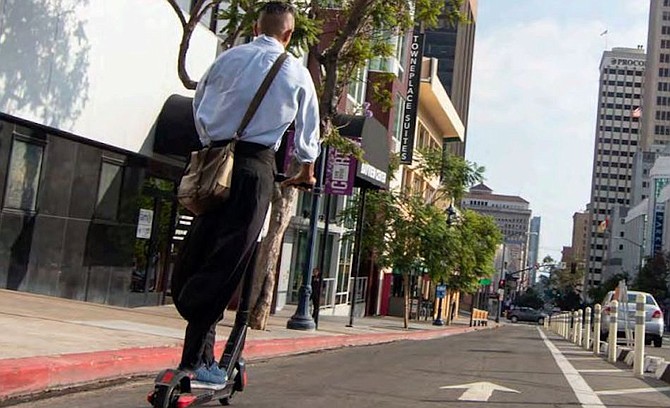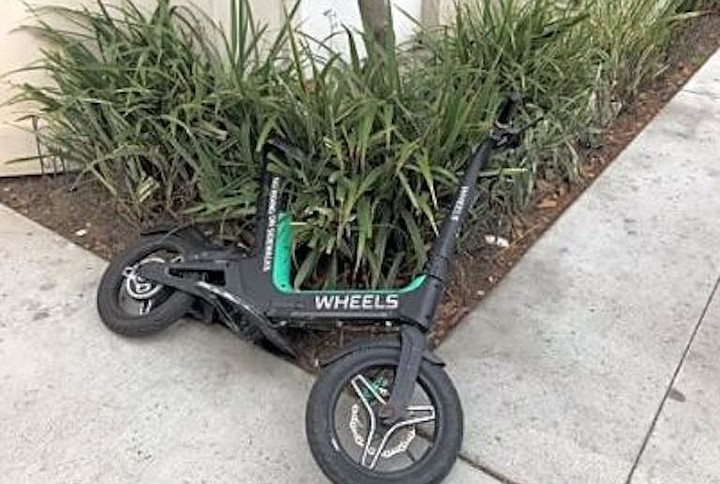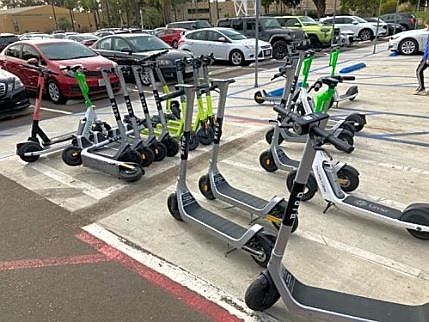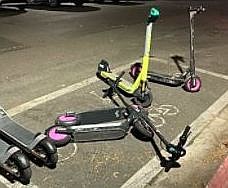 Facebook
Facebook
 X
X
 Instagram
Instagram
 TikTok
TikTok
 Youtube
Youtube

Street life is coming back, and with it, scooter critics.
Motorized scooters are often touted as a first or last mile link in the transit chain, and the city counts them among its mobility choices – but some say they're making it harder for others to get around.
Last month, 561 complaints about scooters were lodged with the city's Get It Done app for sidewalk blocking and other misuse. The previous January, mid-pandemic, there were only 263 reports.

The Active Transportation and Infrastructure Committee last week approved its 2022 Work Plan, which will include an update to the regulations for "shared dockless mobility devices," as motorized scooters are called.
Safety advocates are asking for changes to the city code, mainly to address lax enforcement.
Six scooter companies are now operating in San Diego (Bird, Link, Lyft, Spin, Veo, and Wheels), but a shift in the process of selecting them is underway. Rather than facing an unlimited number of applicants every two years, the city plans to negotiate individual contracts with just four companies.
By using a request-for-proposals process, the city can choose companies based on how they would oversee riders, for one. The change is meant "to ensure operators and riders are safe, compliant and maximizing community benefit."
The city's RFP (request for proposal) requires companies to use technology to ensure scooters aren't driven on sidewalks. It limits the number of devices to a maximum of 8,000, aims to expand distribution of devices throughout the city, integrated with the public transit system, and serve under-served areas.

Safe Walkways, a group of downtown and beach area neighbors that formed in 2018 to fight for their safe share of the increasingly hectic sidewalks and plazas, supports the new method.
"Some elements of the RFP appear to deal with major problems," they said, like the citywide requirement that scooters be parked and staged in the street, not on sidewalks. But they oppose any loosening of city oversight to allow companies to "self manage."
Currently, city rules bar scooters from blocking traffic lanes and sidewalks. They may be parked on sidewalks in allowed zones where they don't block pedestrians, aren't on the same block as a shared mobility device corral (where they are supposed to park), and are no closer than 40 feet of another corral on a city sidewalk.
Where there is no corral in allowed zones, up to four devices can be parked together no more than a foot apart. Complaints show they sometimes overflow, described as "messy" in reports.

Other placement no-nos include blue parking spots; within 500 feet of a hospital or K-12 school; and within six feet of a designated bus or trolley stop, transit shelter, bench, or kiosk.
According to the city's website, the city has shared applicable rules, regulations and safety guidelines with the scooter rental companies "and is monitoring the operations to ensure the companies and their customers are aware" of them.
The city pays a company to remove abandoned or illegally parked scooters when reported. But the Safe Walkways group says the city has moved away from impounding, its only enforcement tool for parking issues. "It does almost no impounding at all any more."
Without effective enforcement, the rules can be ignored, they say.
According to the group, there were over 21,000 Get It Done reports of parking issues associated with shared mobility devices in 2021.
They suggested that the companies be required to install geofencing, which can automatically reduce riders’ speeds on all streets with speed limits faster than 25 mph.
While scooters are supposed to ride in the bike lane, or on roads in certain speed-restricted zones, when protected lanes aren't available, sidewalks beckon.


Street life is coming back, and with it, scooter critics.
Motorized scooters are often touted as a first or last mile link in the transit chain, and the city counts them among its mobility choices – but some say they're making it harder for others to get around.
Last month, 561 complaints about scooters were lodged with the city's Get It Done app for sidewalk blocking and other misuse. The previous January, mid-pandemic, there were only 263 reports.

The Active Transportation and Infrastructure Committee last week approved its 2022 Work Plan, which will include an update to the regulations for "shared dockless mobility devices," as motorized scooters are called.
Safety advocates are asking for changes to the city code, mainly to address lax enforcement.
Six scooter companies are now operating in San Diego (Bird, Link, Lyft, Spin, Veo, and Wheels), but a shift in the process of selecting them is underway. Rather than facing an unlimited number of applicants every two years, the city plans to negotiate individual contracts with just four companies.
By using a request-for-proposals process, the city can choose companies based on how they would oversee riders, for one. The change is meant "to ensure operators and riders are safe, compliant and maximizing community benefit."
The city's RFP (request for proposal) requires companies to use technology to ensure scooters aren't driven on sidewalks. It limits the number of devices to a maximum of 8,000, aims to expand distribution of devices throughout the city, integrated with the public transit system, and serve under-served areas.

Safe Walkways, a group of downtown and beach area neighbors that formed in 2018 to fight for their safe share of the increasingly hectic sidewalks and plazas, supports the new method.
"Some elements of the RFP appear to deal with major problems," they said, like the citywide requirement that scooters be parked and staged in the street, not on sidewalks. But they oppose any loosening of city oversight to allow companies to "self manage."
Currently, city rules bar scooters from blocking traffic lanes and sidewalks. They may be parked on sidewalks in allowed zones where they don't block pedestrians, aren't on the same block as a shared mobility device corral (where they are supposed to park), and are no closer than 40 feet of another corral on a city sidewalk.
Where there is no corral in allowed zones, up to four devices can be parked together no more than a foot apart. Complaints show they sometimes overflow, described as "messy" in reports.

Other placement no-nos include blue parking spots; within 500 feet of a hospital or K-12 school; and within six feet of a designated bus or trolley stop, transit shelter, bench, or kiosk.
According to the city's website, the city has shared applicable rules, regulations and safety guidelines with the scooter rental companies "and is monitoring the operations to ensure the companies and their customers are aware" of them.
The city pays a company to remove abandoned or illegally parked scooters when reported. But the Safe Walkways group says the city has moved away from impounding, its only enforcement tool for parking issues. "It does almost no impounding at all any more."
Without effective enforcement, the rules can be ignored, they say.
According to the group, there were over 21,000 Get It Done reports of parking issues associated with shared mobility devices in 2021.
They suggested that the companies be required to install geofencing, which can automatically reduce riders’ speeds on all streets with speed limits faster than 25 mph.
While scooters are supposed to ride in the bike lane, or on roads in certain speed-restricted zones, when protected lanes aren't available, sidewalks beckon.
Comments